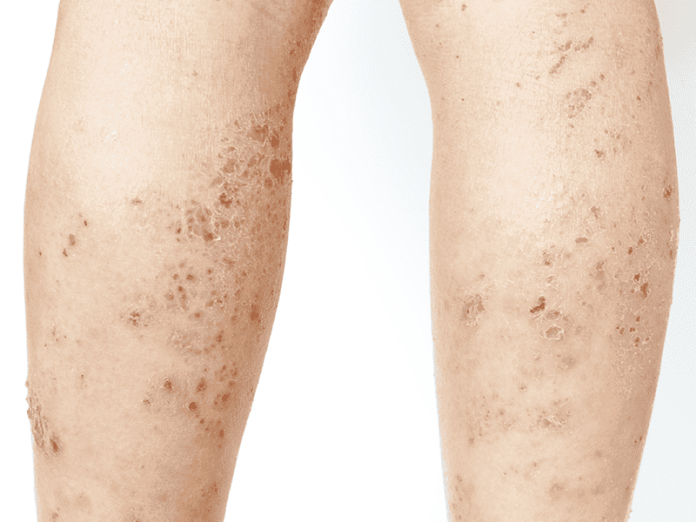Estimated reading time: 0 minutes
Lichen Planus (LP), a chronic inflammatory disorder characterized by its distinctive purplish, itchy, flat bumps on the skin, has long puzzled both patients and practitioners with its complex manifestation and uncertain origins. This condition’s multifaceted nature affects not only the skin but also mucous membranes, along with potential impacts on hair and nails, presenting a broad spectrum of symptoms. The quest for effective treatments has led to the exploration of diverse therapeutic avenues, from the conventional realm of Western medicine, which often leans on steroids, to the ancient holistic approach of Ayurveda. This exploration offers an in-depth analysis of the treatment modalities for Lichen Planus, delving into the action mechanisms, advantages, and drawbacks of both steroids and Ayurvedic remedies.
The Role of Steroids in Managing Lichen Planus
Action Mechanisms
Corticosteroids, the frontline defense in the conventional treatment paradigm, serve as potent anti-inflammatory agents. Their primary mechanism involves dampening the immune system’s overactive response, thereby alleviating inflammation, redness, and itchiness that hallmark LP. Topical applications are the norm for treating skin lesions, while oral formulations are reserved for more severe manifestations.
Advantages
– Swift Symptomatic Relief: The most notable benefit of steroid therapy is its ability to quickly mitigate the acute symptoms associated with LP, such as the intense itching and inflammation.
– Widespread Availability: Steroids are readily accessible across healthcare settings, making them a go-to option for immediate intervention.
– Proven Efficacy: Decades of clinical use and research back the effectiveness of steroids in providing symptomatic relief for LP.
Drawbacks
– Adverse Effects: The long-term application or consumption of steroids can induce several adverse effects, including skin atrophy, heightened infection risks, and potential systemic impacts from oral use.
– Symptomatic Approach: While steroids can offer temporary reprieve from LP’s manifestations, they do not address the condition’s root causes, leading to possible symptom recurrence post-treatment cessation.
Ayurveda’s Approach to Treating Lichen Planus
Ayurveda, with its origins in the Indian subcontinent, proposes a holistic route to combating LP, emphasizing the restoration of bodily balance and purification.
Action Mechanisms
The Ayurvedic strategy encompasses dietary guidelines, herbal formulations, lifestyle adjustments, and detoxification techniques collectively known as Panchakarma. This multifaceted approach aims at rebalancing the doshas and enhancing the digestive fire (Agni), crucial for the eradication of toxins (Ama) that may exacerbate LP.
Advantages
– Comprehensive Care: Ayurveda’s strength lies in its holistic consideration, tackling not just the physical symptoms but also addressing mental and spiritual well-being.
– Sustained Wellness: The lifestyle and dietary modifications advocated in Ayurveda promise enduring benefits, transcending mere symptom management.
– Reduced Side Effects: Given their natural composition, Ayurvedic remedies are typically associated with minimal adverse effects, offering a safer alternative to synthetic drugs.
Drawbacks
– Delayed Results: The nature of Ayurvedic treatment is such that visible improvements take time, requiring patience from the patient’s end.
– Accessibility Challenges: Finding proficient Ayurvedic practitioners and quality-assured herbal products can be challenging, particularly outside India. Additionally, the herbal remedy sector suffers from a lack of standardization, raising concerns about consistency and efficacy.
A Comparative Overview
– Treatment Philosophy: Steroidal interventions are symptom-focused, aiming at quick relief through immune suppression and inflammation reduction. Conversely, Ayurveda adopts a comprehensive view, seeking to rectify the underlying imbalances that contribute to LP’s onset.
– Safety and Side Effects: The potential for significant side effects looms large with steroid use, especially when employed long-term. Ayurvedic treatments, rooted in natural substances, generally pose fewer risks, albeit with the caveat of requiring expert preparation and administration.
– Treatment Sustainability: Steroids might not offer a permanent solution, with symptoms likely to recur after stopping treatment. Ayurvedic practices advocate for sustainable lifestyle changes, promising more permanent resolutions, albeit with greater time investment and adherence required.
– Evidence and Validation: The scientific literature robustly supports steroids’ efficacy in symptom management for LP, offering a solid evidence base. Ayurvedic treatments, while steeped in centuries of traditional practice, are gaining ground in scientific research, with emerging studies validating their therapeutic potential.
Paths for Comprehensive Care
In weighing the options for Lichen Planus management, it becomes evident that both steroids and Ayurveda present distinct benefits and limitations. The decision-making process thus hinges on individual circumstances, severity of symptoms, and personal health philosophies. For those seeking immediate symptom alleviation, steroids provide a viable albeit temporary solution. In contrast, Ayurveda appeals to those inclined towards addressing the root causes of LP and achieving long-term well-being, requiring patience and lifestyle commitment.
An integrated treatment strategy, under the guidance of healthcare professionals, can offer a balanced approach to managing Lichen Planus. This confluence of rapid symptomatic relief through steroids and the holistic, preventive, and curative measures of Ayurveda encapsulates a comprehensive pathway to navigating LP, blending immediate comfort with long-term health optimization.
Related-
Know More About Ayurveda Treatment For Lichen Planus.
GET IN TOUCH


Recent comments